Utah March 3
Wyoming March 15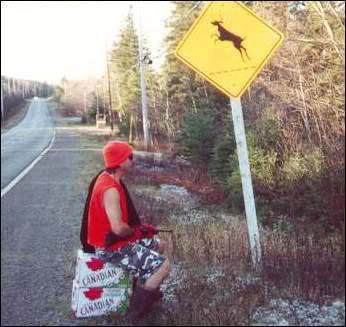
New Mexico March 28
Colorado April 6
Nevada April 18
Kansas April 29
Oregon May 15
Washington May 26
California June 1
Montana June 1
Idaho June 5
Arizona June 8
South Dakota July 23
Utah March 3
Wyoming March 15
New Mexico March 28
Colorado April 6
Nevada April 18
Kansas April 29
Oregon May 15
Washington May 26
California June 1
Montana June 1
Idaho June 5
Arizona June 8
South Dakota July 23
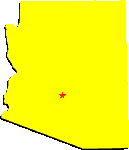
If you want to take your chances at drawing an Arizona Mule Deer Tag, don’t wait too much longer. The deadline is June 8, 2010. You may purchase a license first or apply for one as part of the drawing. You cannot apply online for the draw.
Click ARIZONA APPLICATION for the application.
Or select the States Tab for more information.
Good Luck
I bowhunted the North Rim this year and attempted to talk to as many hunters as possible. Most hunters were seeing bucks and most were getting some shots, but only five, that I’m aware of, bagged bucks. There was rumor of a big buck being taken from the southwest quadrant on opening day, then there was this buck taken by a young man who said he missed shots at some big ones:

This young man was with an older person who had spent considerable time scouting and preparing for the upcoming rifle hunt. Here are a couple of his friend’s tree cam shots:


Getting an archery buck from the North Rim is difficult, but there are a few good ones available.
Earlier in the year, some folks were predicting that it would be a good year for antler growth, based on a wet spring and good feed. Having now been out bowhunting, I have the following observations for Southern Utah and Northern Arizona:
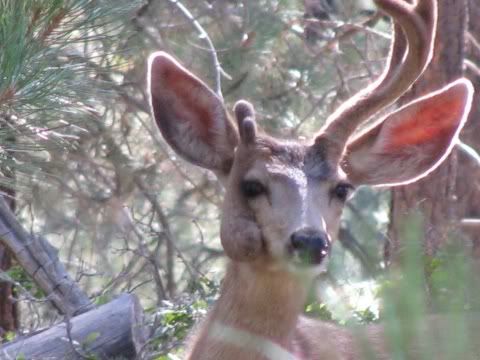
The following quote demonstrates to me that the USFWS is more anti-sportsman than pro and is an agency with far too much power over state wildlife agencies. State wildlife agencies have their issues as well, but provided that a state agency wishes to serve the sportsmen that fund them, they must still cope with the USFWS.
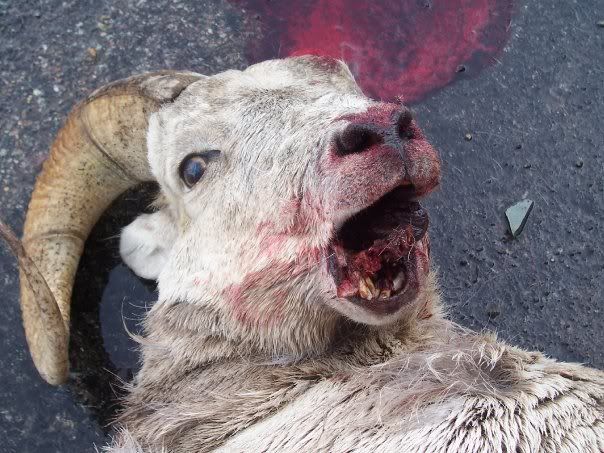
We need to stop lions from killing mule deer as much as we need to stop them from killing big horn sheep. At present lions are killing over ten times as many mule deer as hunters are annually.

———————————
On Friday, TOMORROW, August 7 the Arizona Game & Fish Commission will consider extending the Kofa lion removal moratorium which ended July 31. It is critical to the survival of the Kofa herd that the moratorium NOT BE EXTENDED.
According to information provided by the Az. Game & Fish Department (AZGFD) the Kofa desert bighorn sheep population declined from 800 sheep in 2000 to 390 sheep in 2006. Predation by mountain lions was found to be one of the causal factors in the decline.
Based upon that report the AZGFD developed a variety of action plans to address the identified issues, including a mountain lion predation management plan. As part of the predation management plan, two mountain lions that were trapped on the refuge were lethally removed and the USFWS was immediately challenged for allowing these activities to occur prior to completion of an Environmental Analysis (EA).
At the request of USFWS, the Department agreed to a one year Moratorium on lethal removal of lions captured on the refuge.
On April 23, 2008, the USFWS released a scoping letter to gather input prior to completing the EA.
In 2008, at the request of Arizona Sportsmen for Wildlife, the Arizona Legislature sent a House Concurrent Memorial to Congress on this very issue. The Legislature asked Congress to “take immediate action to reaffirm the Arizona Game & Fish Department’s position as the leading agency in the management of non-migratory and non-endangered state wildlife” and that the AZGFD be allowed to “employ, without any unnecessary delays, burdens or obstacles, all management tools and measures necessary to recover the Kofa National Wildlife Refuge desert bighorn sheep population, including the management of predators, water developments, human intervention and the potential for disease epizootics. To date, no action has been taken by Congress and USFWS has done nothing to facilitate or otherwise allow AZGFD to manage its wildlife in the Kofa.
On April 18, 2009 the USFWS requested an additional extension of the Moratorium indicating they needed more time to complete the EA. The Commission extended the Moratorium for 90 days and that moratorium ended on July 31, 2009.
Today, while the USFWS has printed its findings from the EA in the Federal Register, it is highly unlikely that a final decision will be made before March 2010 and mountain lions will continue to kill sheep on the Kofa. At last report one of the offending lions known as KMO4 has killed 14 sheep, averaging one sheep every ten days. And KMO4 is not the only offending lion on the Kofa. The Department’s Timeline shows that sheep have been taken by more than one other offending lion on the Kofa.
According to an article in the Arizona Republic, Representative Daniel Patterson (D-Dist 29, Tucson) does not want the AZGFD to shoot lions until the federal government finishes an environmental study on the issue early next year as requested by USFWS. AZSFW does not agree with Representative Patterson as the facts of offending lion, KMO4, speak for themselves.
Rep. Patterson was formerly affiliated with the Southwest Center for Biological Diversity and is reported to be the Ecologist and Southwest Director for Public Employees for Environmental Responsibility since 2006.
It is time for the Commission to say “No More Time” and direct the Department to lethally remove the offending lion as soon as possible. It is the responsible thing to do.
Please call or write members of the Commission and ask them to support AZSFW’s request to lethally remove the offending lion and tell USFWS no more moratoriums. The Kofa desert bighorn sheep herd can no longer afford to be held hostage to bureaucratic inefficiencies.
Pete Cimellaro
AZSFW Board Member

As is being pointed out by Arizona meteorologists: Northern Arizona has had unusual moisture and coolness for springtime. Typically, the season for moisture is late summer/early fall when the monsoons arrive. Because of the early moisture and the abundance of feed it promoted, some are forecasting a year for massive antlers. If you are lucky enough to have an Arizona Mule Deer tag, let us know what you think of this forecast.
A ten year-old boy by the name of Paul John Schalow was attacked by a mountain lion early in March 2008 when visiting Arizona’s Tonto National Forest. The lion turned out to be rabid.
The boy was commanded to stand still by family members and did so even when the cat started scratching and biting. The boy’s uncle ran to get a handgun and dispatched the lion, which later proved to be rabid. A series of six shots prevented the boy from getting infected.
The boy and his family inadvertently saved the lives of many mule deer. For that they ought to be congratulated.

June 9 is the deadline to apply for a mule deer hunt in Arizona. You must apply by mail. Online applications are not accepted. Go to the states tab and click on Arizona for more information.
There seems to be no limit to the number of mule deer that can be killed by mountain lions, but what what happens when lions prey on bighorn sheep? My current estimate of the number of mule deer killed by mountain lions anually in Arizona is 170,000. What if an “offending mountain lion”, as referenced in the following article, were one that killed two mule deer within a six month period, as opposed to killing two big horn sheep?
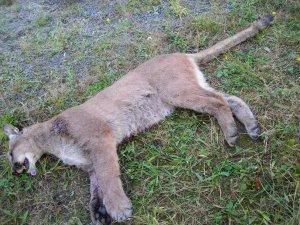
———————————–
Arizona Game and Fish extends moratorium limiting mountain lion predation management on the Kofa National Wildlife Refuge
April 18, 2009
PHOENIX — As part of its continued efforts to restore the Kofa National Wildlife Refuge’s (NWR) struggling desert bighorn sheep herd, the Arizona Game and Fish Commission voted today, at its regularly scheduled meeting, to extend through July 31 the Department’s self-imposed moratorium on lethally removing offending lions captured and collared on the Refuge. As defined by the 2007 Kofa Mountains Predation Management Plan, an offending lion is one that kills at least two bighorn sheep within a 6-month period.The decision to extend the moratorium through the July 31 date reflects the U.S. Fish and Wildlife Service’s (Service) estimated timeline of the end of the public scoping period for the environmental assessment (EA) for managing mountain lion predation on desert bighorn sheep on the Refuge. The Service now anticipates completing the EA by the end of 2009.
The department’s original one-year moratorium was enacted in April 2008 as a cooperative agreement with the Service, and it expired yesterday, Friday, April 17. When established, the one-year moratorium reflected a Service estimate of six months to complete the EA. Lions captured and collared outside the Refuge are not subject to the moratorium.
The Service requested the department to extend the moratorium due to the complexity of conducting the environmental assessment.
The moratorium extension provides one exclusion.
In late February, the department collared a lion, KM04, on the refuge during the original moratorium. This lion, currently the only one captured and collared on the refuge, has already preyed upon three bighorn sheep and qualifies as an offending lion. Under the extended moratorium, the KM04 lion’s predation history will be reset to zero as of today’s decision. However, if KM04 qualifies as an offending lion again, he will not be covered under the new moratorium.
“The Kofa bighorn sheep herd is critically important to the sheep restoration efforts in Arizona and much of the Southwest,” said Gary Hovatter, deputy director for the department. “The very low rate of herd recruitment – approximately 40 yearlings per year – makes any additive mortality to this herd – be it due to drought, disease, forage quality, or other factors — an issue of critical interest to the department and its stakeholders – the citizens of Arizona.”
Hovatter added, “mountain lions are also an important species to the department and the eco-system. Their populations are very healthy throughout the state and are managed like all other big game species. Removal of lions on the Kofa NWR does not threaten the health of Arizona’s mountain lion population.”
The Kofa desert bighorn sheep herd was once one of the most robust herds in the nation and has been a critically important source of transplant sheep for restoring desert bighorn sheep to Arizona and other southwestern United States mountain ranges for 51 years. Historically the Refuge has been home to a population averaging 760 bighorns. However, since a survey in 2000, the population has continued to decline. The 2006 survey count reflected a historic low estimated population of 390 animals.
Wildlife experts attributed the decline to a variety of potential factors including drought, predation, wildlife water management, disease factors and human disturbance. At the beginning of restoration efforts in 2006, it was estimated that at least five lions had been spending enough time in the refuge portion of the Kofa Mountains Complex to be considered “resident.” Given the historical indications of the transient nature of the lion presence on the Kofa, these resident lions are likely an important cause of additive bighorn mortality.
Friend and fellow blogger, Kevin Paulson, sent me this photo of a recent Arizona Strip Buck killed by a hunter named John. Visit Kevin’s website by clicking on the Hunting Life link in the sidebar.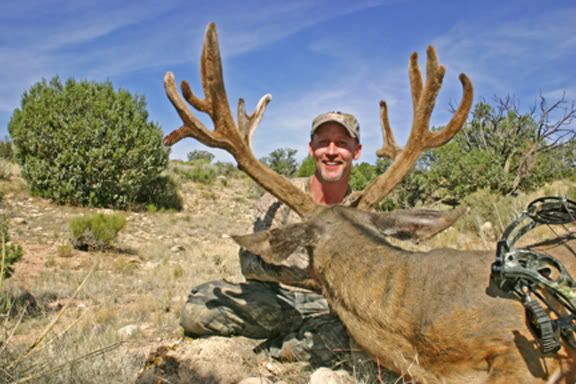
Good work, John